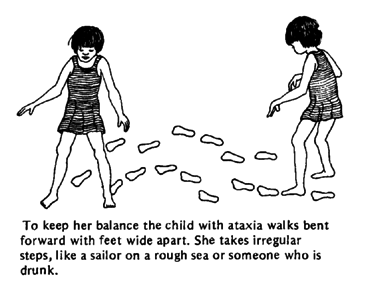
Angelman syndrome, caused by a genetic defect on chromosome 15, includes developmental delay, near absence of speech, and facial abnormalities. The most striking characteristic of someone with Angelman syndrome, though, is the appearance of being happy most of the time, with frequent smiling and prolonged episodes of laughter.
Angelman syndrome may occur in people of all ethnic backgrounds. About 70-75% of individuals born with Angelman syndrome have no family history of the disorder
Symptoms:
Individuals with Angelman syndrome share common characteristics:
* Developmental delay and functional impairment
* Disparity between understanding language and speaking; speaks few or no words; may be able to use nonverbal gestures
* Short attention span, hyperactivity, easily excitable, appears happy, frequent smiling and/or laughing
* Difficulty with movement or balance, including difficulty walking and/or tremors of limbs.
In addition, individuals with Angelman syndrome may have:
* Seizures of any type
* Delayed, disproportionate growth of head in childhood
* Hypopigmented skin and eyes
* Wide mouth, widely-spaced teeth, protruding tongue, drooling, feeding problems and frequently putting things in the mouth during infancy
* Sleep disturbance.
Diagnosis:
Since Angelman syndrome is a genetic disorder, infants are born with it. Parents begin to notice when their child is between 6-12 months of age that developmental milestones are not being met, such as sitting alone without support and standing up. Jitteriness or tremors of the limbs may be present, and once the child begins walking there may be toe-walking, lurching forward, or a jerky gait.
The child may be given the diagnosis of cerebral palsy based on these symptoms. However, the child’s behaviors of constant smiling and laughing, but not talking, point towards a diagnosis of Angelman syndrome. The diagnosis is based on the symptoms present, as there is no specific test for the syndrome.
Treatment:
Specific medical treatment may be needed for problems such as seizures, feeding problems, or sleep disturbance. Physical therapy is helpful for improving walking, and occupational therapy can help the child develop everyday living skills . The child with Angelman syndrome needs consistent behavioral management and supervision, and will require special provisions to be integrated into the classroom. Speech and communication therapy can help the child, if able, to develop nonverbal means of communication and use communication aids such as pictures to express needs. Individuals with Angelman syndrome generally have good health and can be expected to live a normal life span.
Angelman Syndrome Foundation Takes Major Step Toward Furthering Research Efforts
The Angelman Syndrome Foundation, http://www.angelman.org, announced the formation of the Angelman Treatment and Research Institute (ATRI), which will direct the organization's rapidly increasing research funding. The ATRI will also serve as a hub for more than 30 organizations, researchers and scientists worldwide to share discoveries and treatments for this neuro-genetic disorder. The announcement of the ATRI was made during the Angelman Syndrome Foundation's biennial conference in Orlando, Fla.
source: rarediseases.about.com


